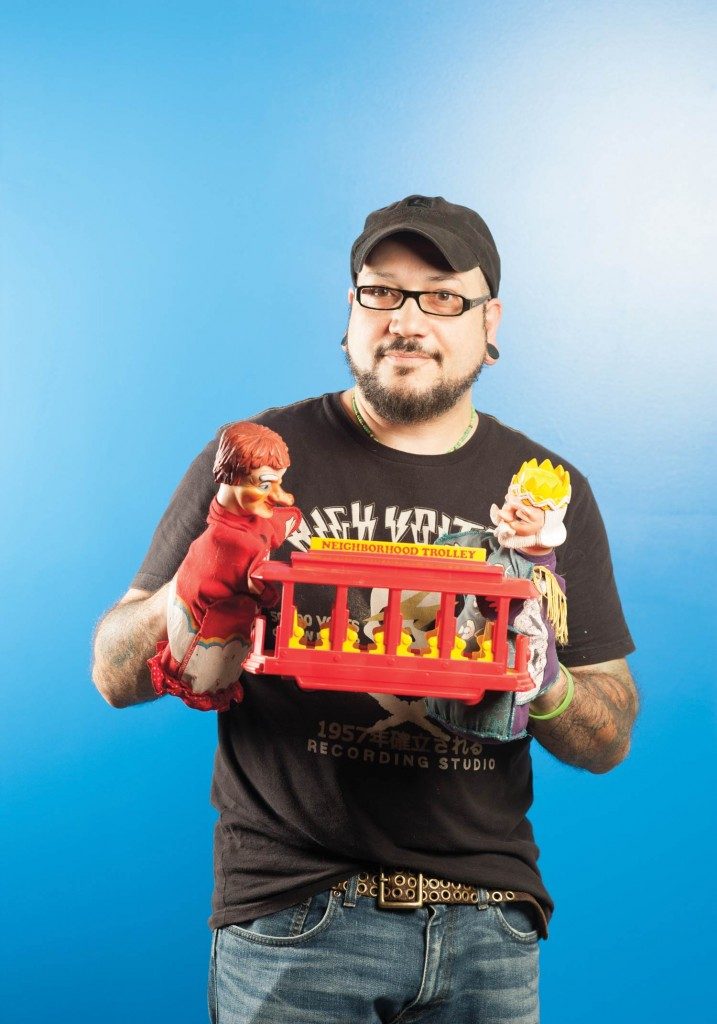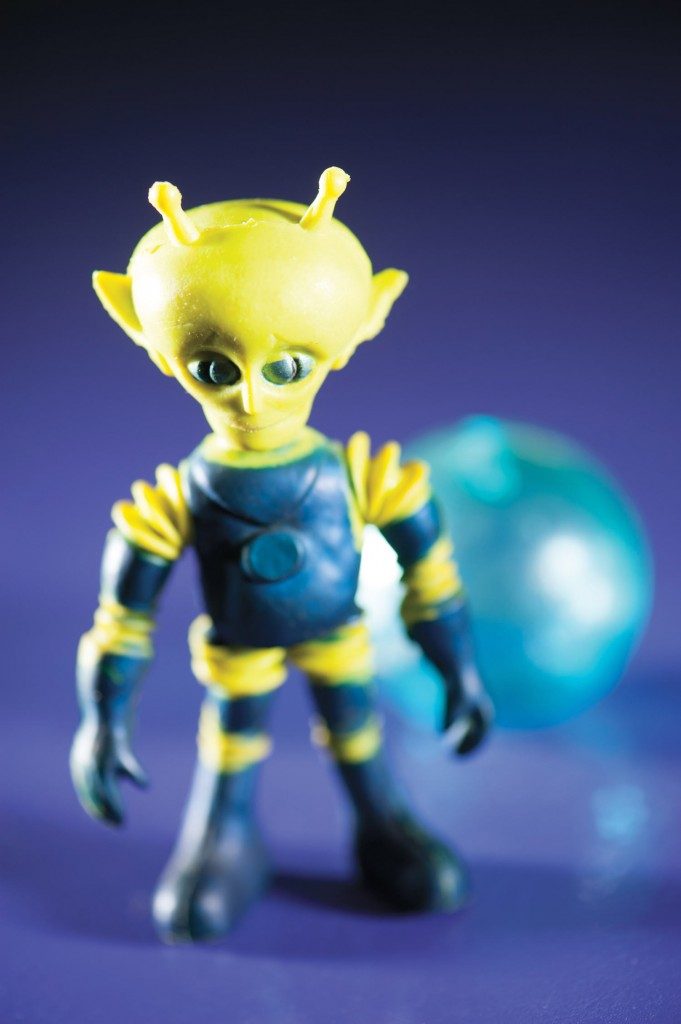With generations’ worth of toys on display-think pop-culture icons rather than antique artifacts-a playful Salem museum evokes childhood nostalgia. photo essay by Kindra Clineff, text by Scott Kearnan
Lions, tigers, and frogs-oh my! Owner Frank Sarcia has turned his Salem Toy Museum into a menagerie of beloved characters from barely-bygone eras, like this stuffed Kermit, his favorite member of The Muppets. The Museum focuses on iconic, instantly recognizable toys that have permeated pop culture. Sarcia says they get the strongest reactions from guests who are eager to share their nostalgic trip down memory lane. “I thought the toys would be the best part,” says Sarcia about opening his Museum. “It turns out that the people are the best part. The stories I hear are awesome.”
The holidays are a particularly appropriate time to tour the new Salem Toy Museum. After all, founder Frank Sarcia has culled a collection that looks like an intergenerational cross-section of happy Christmas mornings. Here, 1980s action figures pose on shelves. (Ninja Turtles, anyone?) Metal lunchboxes pay tribute to 1970s blockbusters (E.T., phone home!). And the 1960s are honored with stacks of retro boardgames and fun, funky finds. (Will Robinson would enjoy the Lost in Space robot.) “Opening this was my dream,” says Sarcia, a graphic designer by trade anda lifelong toy enthusiast. His personal collection makes up most of the Museum, and while many toys are lovingly preserved in original packaging, others show tender, timeworn signs of childhood play. That’s because monetary value doesn’t motivate Sarcia’s collecting; instead, he wants to celebrate the joy of toys and the shared sense of nostalgia they invoke. And whereas most toy museums spotlight antique artifacts, he focuses on comparatively modern decades (1950s onward), in which toys became mass pop culture icons. (Think Smurfs and H.R. Pufnstuf, not wooden trains and porcelain dolls.) Special upcoming showcases will highlight Star Wars and Charles Schultz’s Peanuts. For many guests, the flood of happy memories is deeply touching. “One woman broke down crying when she saw the Easy-Bake Oven. She hadn’t thought about it in years,” recalls Sarcia. Awe, excitement, and even tears of joy? Move over, Santa. There’s a new toy titan in town.
The Smurfs (1970s)
Salem Toy Museum guests browse the collection on self-guided tours, but Sarcia is happy to answer questions, share background on the exhibits, and provide a healthy dose of toy trivia. After all, these items are also cultural artifacts that reveal a lot about the eras that popularized them. Take the black Smurf, part of a collection created before the comic strip characters were popularized by a 1980s TV cartoon. The angry figurine was eventually taken off the market, says Sarcia, because of the racist connotations it conjured.

Mister Rogers Trolley (1970s)
The museum holds plenty of hard-to- find toys, like this musical trolley made famous by Mister Rogers Neighborhood. Sarcia started his museum after the graphic designer was laid off by a Boston architecture firm and currently runs it as a one-man show. But its June opening was a longtime dream for the avid toy collector, a warm, friendly host whose new business is bound to keep him young at heart. “I think I tend to glorify childhood as being the best time of life,” says Sarcia, 50, explaining his fondness for toys. “Of course, that’s probably because now I’m working my butt off all the time. Then, all I had to do was go out and play!”
Toying Around
The museum’s toys primarily reflect the 1950s-1980s. Sarcia says he initially thought guests would be interested in the older toys, but he has increasingly been adding ’80s items in response to requests. “As people walked through, they’d say, ‘Where is He-Man? Where are the Ninja Turtles?'” From Fred Flintstone to the Pink Panther, guests will be reunited with plenty of familiar faces. And they’ll meet some new friends, too: like Zilcho and Zilly, a pair of green slugs designed by Sarcia that serve as the museum’s mascots. Eventually, stuffed versions will be sold in the gift shop, which is already stocked with plenty of take-home trinkets.
 Pee-Wee Herman Doll and the General Lee (1980s)
Pee-Wee Herman Doll and the General Lee (1980s)
Many of the fun finds in the Salem Toy Museum have ties to TV, like this pull-string Pee-wee Herman doll and remote-control model of the General Lee, the ride made famous by those daredevils in The Dukes of Hazzard. Shows like those weren’t just entertainment; many of them were also commercials aimed at kids and introduced a whole new way to mass market tie-in merchandise. Because toys of decades past are so often associated with our favorite TV shows and movies, from Saturday morning cartoons to blockbuster film franchises, they’ve transcended just being toys. “They were hammered through the TV year after year,” says Sarcia of how toys could become ingrained in kid consciousness. “After something has been around for so long, it becomes iconic.” What media most influenced him? Sarcia says that would have to be H.R. Pufnstuf. He’s since reached out to the show’s creators, brothers Sid and Marty Krofft, to tell them about the Toy Museum, and he got a gratifying thumbs-up from his childhood heroes. “They were honored to have inspired it!” says Sarcia. Another favorite? The Planet of the Apes series; Sarcia even has an Apes-inspired tattoo on his arm.
The Full Package
The toys are a colorful, eye-popping assortment-from the kitschy, retro graphics on tin lunch pails to the fanciful looks of the toy boxes. When he can, Sarcia displays the toys in their original packaging-not to preserve their monetary value, but to keep intact the exciting, eye-catching appeal that first called out to kiddies in a toy store aisle. “Growing up, the boxes and packaging were a huge part of what attracted me to the toys,” says Sarcia, which makes sense for an eventual graphic designer. “To people who know toys, that’s the best part!”
 Colorform Alien (1960s)
Colorform Alien (1960s)“My dad would always bring me home the weirdest toys,” remembers Sarcia with a laugh. He loved them all, and today the Toy Museum is stocked almost entirely with his own collection. That includes plenty of those awesome childhood oddities, like the Cragstan Kitchen Robot (center, opposite page), an android with a cheese grater body and spatula arms. Then there’s this Colorform Alien, “Alpha 7, The Man From Mars,” which Sarcia says was his constant companion as a kid. (“You know how you get to pick one toy to take with you in the car? This was it.”) Maybe that’s the best thing about the Salem Toy Museum; childhood can’t last forever, but a visit here proves we never have to say goodbye to our old favorite playmates.
Â

